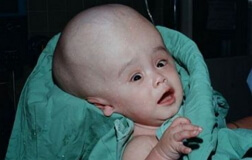Antiphospholipid syndrome in children

Antiphospholipid syndrome is a complex of symptoms based on the presence of an autoimmune reaction and antibodies to fairly common phospholipid determinants that are found on the membrane of nervous tissue, platelets and endothelial cells.
For the first time AFS was described in the year 86 of the twentieth century by an English rheumatologist. Since then, an intensive study of the clinical and pathophysiological features of the syndrome has begun. Criteria for diagnosis were formulated in 1998 at an international symposium and are divided into laboratory and clinical.
Clinical criteria
Vascular thrombosis. It is manifested by the appearance of one or more clinical episodes of venous thrombosis or arterial, as well as thrombosis of small diameter vessels in any organ or tissues. Thrombosis should be confirmed by ultrasound Doppler scanning or data after histological examination, except in cases where superficial venous thrombosis is observed. Histological examination should show a significant change in non-inflammatory vascular walls.
Laboratory criteria
A high or moderate level of anti-cardiolipin IgM and / or IgG antibodies in the blood should be obtained after two or more studies at intervals of not less than six weeks. Measurements should be conducted by standard and enzyme immunoassay.
Positive test for the presence of lupous anticoagulant in the plasma after two or more studies that were performed with a difference of not less than 6 weeks.
A reliable syndrome is diagnosed only if at least one clinical and one laboratory test is obtained. The criteria are developed for adults and do not take into account the age features of children.
Detection of this disease in pediatrics is important from a prognostic point of view, since it has a high risk of thrombotic processes, and also determines the course and the final outcome of the underlying disease. For the first time the connection between vascular thrombosis and the presence of circulating anticoagulant was noticed in 1972 in children who had systemic lupus erythematosus.
Antiphospholipid syndrome in children is diagnosed if there is a clinical criterion and at least one laboratory test.
It should be noted that if there is a suspicion of APS in a child, it is important to have a family history, that is, the presence of certain diseases in relatives: recurrent strokes and heart attacks, especially in people under 50, rheumatic diseases, eclampsia, preeclampsia or miscarriagePregnancy, recurrent thrombophlebitis.
Clinical variants of AFS
Primary( PAPS) - develops in people who do not have any autoimmune diseases.
Secondary( VAPS) - develops in people who suffer from diseases of rheumatoid or autoimmune nature, with neoplasms that are recognized as malignant, infectious diseases( mycoplasmosis or herpesvirus infection), with the use of certain medicines( psychotropic substances, contraceptive or hormonal, Novokainamid).
Catastrophic is a multi-systemic type when there are mainly organ thromboses at the level of the microcirculatory bed with a large number of antibodies to phospholipids, multiple organ organ damage, disseminated intravascular activation with the presence of thrombosis in the vessels, having a small diameter. For this type of syndrome, the diagnosis criterion in children is the presence of a thrombotic process in at least three systems of the body with confirmation after a histological examination of the microvascular occlusion, as well as the presence of antibodies to phospholipid determinants.
Neonatal. This is a rare pathology that occurs in newborns when transferred by the transplacental route from the mother, which has a high level of antiphospholipid antibodies.
There are serological options - it is seropositive and seronegative.
In children, the antiphospholipid syndrome most often occurs in the first two species.



